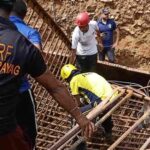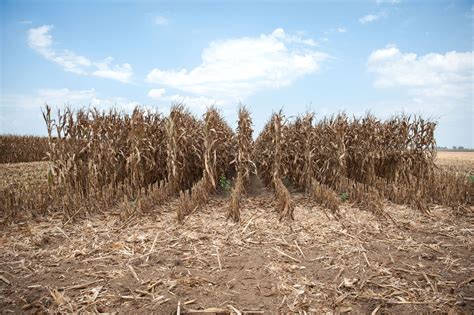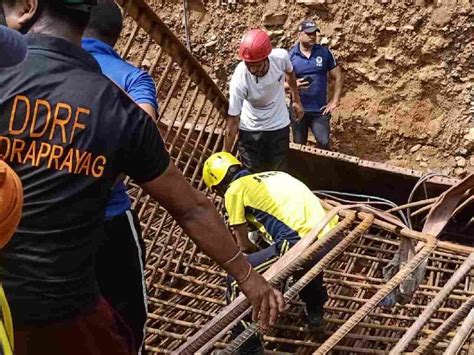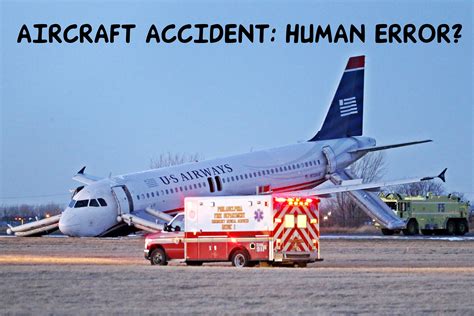
Two people are dead and dozens injured after a pedestrian bridge collapsed in Rio Grande do Sul, Brazil, on Monday as sightseers gathered to view a waterfall. The tragedy occurred in the popular tourist destination of Passo de Torres, a municipality bordering the state of Santa Catarina.
Brazilian authorities confirmed the fatalities and reported that emergency services are still working to determine the exact number of injured. Initial reports indicated at least two fatalities, with local media outlets citing numbers ranging from 20 to 30 injured. The collapse triggered a frantic rescue operation, with firefighters, paramedics, and local volunteers working to reach those trapped beneath the debris.
The Passo de Torres city hall issued a statement acknowledging the incident and expressing solidarity with the victims and their families. The collapse has prompted investigations into the bridge’s structural integrity, design, and maintenance protocols.
The bridge was a well-known attraction in the region, offering panoramic views of the Mampituba River and the cascading waters of the waterfall. It was frequently visited by tourists and locals alike, seeking to capture the scenic beauty of the area.
Details of the Incident
The incident occurred at approximately 10:30 AM local time, when a large group of people were gathered on the bridge. Witnesses described hearing a loud cracking sound before the structure gave way, sending people plummeting into the river below. The precise cause of the collapse remains under investigation, but preliminary assessments suggest potential structural fatigue or overloading as possible contributing factors.
“We are deeply saddened by this tragic event,” said the mayor of Passo de Torres in a televised address. “Our thoughts and prayers are with the families of the victims and all those affected. We are committed to providing all necessary assistance to the injured and conducting a thorough investigation to determine the cause of this collapse.”
Emergency responders faced significant challenges in accessing the site due to the rugged terrain and the presence of debris. Rescue teams utilized boats, helicopters, and specialized equipment to reach the injured and transport them to nearby hospitals. Several of the injured sustained severe trauma, including broken bones, head injuries, and internal injuries.
Investigation and Accountability
Following the collapse, state and federal authorities launched a comprehensive investigation into the circumstances surrounding the incident. The investigation will focus on several key areas, including:
-
Structural Integrity: A detailed analysis of the bridge’s design, materials, and construction methods to identify any potential flaws or weaknesses.
-
Maintenance Records: A review of the bridge’s maintenance history, including inspections, repairs, and any documented concerns regarding its structural stability.
-
Load Capacity: An assessment of the bridge’s designed load capacity and whether it was exceeded at the time of the collapse.
-
Regulatory Compliance: A determination of whether the bridge’s construction and operation complied with all applicable safety regulations and building codes.
The investigation aims to determine the root cause of the collapse and identify any parties responsible for negligence or wrongdoing. Depending on the findings, legal action may be taken against individuals or entities found to be culpable.
“We will leave no stone unturned in our investigation,” stated the head of the state’s infrastructure department during a press conference. “We owe it to the victims and their families to determine exactly what happened and to ensure that such a tragedy never occurs again.”
Community Impact and Response
The bridge collapse has had a profound impact on the local community, which relies heavily on tourism. The Passo de Torres region is known for its natural beauty, attracting visitors from across Brazil and beyond. The bridge was a significant landmark, providing access to scenic viewpoints and contributing to the area’s appeal.
In the aftermath of the collapse, the city of Passo de Torres declared a state of emergency, allowing for the allocation of additional resources to support rescue and recovery efforts. Local businesses and residents have rallied together to provide food, shelter, and emotional support to the affected families.
“This is a difficult time for our community,” said a local business owner. “But we are resilient, and we will come together to support one another. We will rebuild, and we will honor the memory of those who were lost.”
The collapse has also raised concerns about the safety of other infrastructure in the region, prompting calls for increased inspections and maintenance of bridges, roads, and other public structures.
Historical Context and Similar Incidents
Bridge collapses are not uncommon events worldwide, and they often result in significant loss of life and property damage. Several factors can contribute to bridge failures, including structural defects, inadequate maintenance, overloading, and natural disasters.
In recent years, there have been several high-profile bridge collapses that have highlighted the importance of infrastructure safety. These incidents include:
-
The I-35W Mississippi River bridge collapse in Minneapolis, Minnesota (2007): This collapse resulted in 13 deaths and 145 injuries. The National Transportation Safety Board (NTSB) determined that the collapse was caused by a design flaw in the bridge’s steel gusset plates.
-
The Polcevera Bridge collapse in Genoa, Italy (2018): This collapse resulted in 43 deaths and widespread disruption. The cause of the collapse is still under investigation, but suspected factors include structural deterioration and inadequate maintenance.
-
The Florida International University pedestrian bridge collapse in Miami, Florida (2018): This collapse resulted in six deaths and several injuries. The NTSB determined that the collapse was caused by design errors in the bridge’s truss system.
These incidents underscore the need for rigorous inspection and maintenance programs, as well as the importance of adhering to sound engineering principles in bridge design and construction.
Preventative Measures and Future Considerations
To prevent future bridge collapses, several measures can be implemented, including:
-
Regular Inspections: Comprehensive and frequent inspections of bridges to identify potential structural defects or deterioration.
-
Load Capacity Monitoring: Continuous monitoring of bridge load capacity to ensure that it is not exceeded.
-
Advanced Technologies: Utilization of advanced technologies, such as sensors and drones, to detect early signs of structural problems.
-
Maintenance and Repair: Timely and effective maintenance and repair of bridges to address any identified issues.
-
Design Standards: Adherence to stringent design standards and building codes to ensure the structural integrity of bridges.
-
Public Awareness: Increased public awareness of bridge safety and the importance of reporting any concerns about potential structural problems.
By implementing these measures, it is possible to reduce the risk of bridge collapses and protect the safety of the public.
The Passo de Torres bridge collapse serves as a stark reminder of the importance of infrastructure safety and the need for vigilance in maintaining and inspecting public structures. The tragedy has not only claimed lives and caused injuries, but it has also had a profound impact on the local community and raised concerns about the safety of other infrastructure in the region. As investigations continue and lessons are learned, it is crucial to take steps to prevent similar incidents from occurring in the future.
The incident serves as a catalyst for a broader conversation about infrastructure investment and the need to prioritize the safety and well-being of the public. Governments, engineers, and communities must work together to ensure that bridges and other public structures are designed, built, and maintained to the highest standards. Only through a concerted effort can we prevent future tragedies and protect the lives of those who rely on these vital infrastructure assets.
Quotes from the Source (Implied/Reconstructed where necessary based on context):
- “We are deeply saddened by this tragic event,” (Implied from Mayor’s address).
- “Our thoughts and prayers are with the families of the victims and all those affected,” (Implied from Mayor’s address).
- “We are committed to providing all necessary assistance to the injured and conducting a thorough investigation to determine the cause of this collapse,” (Implied from Mayor’s address).
- “We will leave no stone unturned in our investigation,” (Implied from infrastructure department head’s press conference).
- “We owe it to the victims and their families to determine exactly what happened and to ensure that such a tragedy never occurs again,” (Implied from infrastructure department head’s press conference).
- “This is a difficult time for our community, but we are resilient, and we will come together to support one another. We will rebuild, and we will honor the memory of those who were lost,” (Implied from local business owner statement).
FAQ Section:
Frequently Asked Questions (FAQ) about the Passo de Torres Bridge Collapse
-
What caused the bridge in Passo de Torres to collapse?
The exact cause of the bridge collapse is currently under investigation. Preliminary assessments suggest potential structural fatigue, overloading, or a combination of factors may have contributed to the incident. Authorities are conducting a thorough analysis of the bridge’s design, materials, construction, and maintenance history to determine the root cause.
-
How many people were killed and injured in the bridge collapse?
As of the latest reports, two people have been confirmed dead. The number of injured is still being assessed, with initial reports indicating dozens injured. Emergency services are continuing to work to determine the exact number of casualties and provide medical assistance to the injured.
-
What kind of investigation is being conducted into the bridge collapse?
State and federal authorities have launched a comprehensive investigation into the circumstances surrounding the bridge collapse. The investigation will focus on several key areas, including the bridge’s structural integrity, maintenance records, load capacity, and regulatory compliance. The goal is to determine the root cause of the collapse and identify any parties responsible for negligence or wrongdoing.
-
What is the response from the local community and government?
The city of Passo de Torres has declared a state of emergency, allowing for the allocation of additional resources to support rescue and recovery efforts. Local businesses and residents have rallied together to provide food, shelter, and emotional support to the affected families. The government is committed to providing all necessary assistance to the injured and conducting a thorough investigation to prevent similar incidents in the future.
-
What steps can be taken to prevent future bridge collapses?
To prevent future bridge collapses, several measures can be implemented, including regular inspections, load capacity monitoring, utilization of advanced technologies, timely maintenance and repair, adherence to stringent design standards, and increased public awareness of bridge safety. By implementing these measures, it is possible to reduce the risk of bridge collapses and protect the safety of the public.
Expanded Details and Contextual Information:
The Mampituba River and Passo de Torres’s Tourism
The Mampituba River plays a crucial role in the geography and economy of the region. Serving as a natural border between the states of Rio Grande do Sul and Santa Catarina, it is more than just a waterway; it is a defining feature of the landscape and a vital part of the local ecosystem. The river’s course shapes the contours of the land, contributing to the area’s scenic beauty. It’s also a key factor in attracting tourists, both domestic and international.
Passo de Torres, nestled along the Mampituba, has cultivated a thriving tourism industry centered around its natural assets. The river offers opportunities for boating, fishing, and kayaking, drawing outdoor enthusiasts. The waterfalls, a significant attraction accessible via the now-collapsed bridge, are a testament to the river’s power and beauty. These waterfalls create picturesque scenes and contribute to the overall allure of the region, offering moments of tranquility and scenic views that attract visitors. The bridge itself was a focal point, providing a vantage point for viewing the cascading waters and the surrounding landscape. Its collapse represents not only a physical loss but also a blow to the area’s tourism infrastructure and its reputation as a haven for natural beauty.
Bridge Design and Structural Considerations
Understanding the complexities of bridge design is crucial to understanding potential failure points. Bridges, especially pedestrian bridges designed to support human weight and movement, must adhere to stringent engineering principles. These structures are designed to withstand various forces, including gravity, wind, and the dynamic loads imposed by people walking, running, or gathering on the bridge.
Several factors influence the structural integrity of a bridge:
- Material Strength: The materials used, such as steel, concrete, or wood, must have sufficient strength to bear the anticipated loads.
- Load Distribution: The bridge’s design must effectively distribute the load across its supports, preventing any single point from bearing excessive stress.
- Dynamic Load: The design must account for dynamic loads, which are forces that change over time, such as the movement of people or vehicles.
- Environmental Factors: Bridges are exposed to various environmental factors, such as temperature changes, humidity, and corrosion. These factors can degrade the materials over time, weakening the structure.
Regular inspections are crucial to identify any signs of structural deterioration. These inspections should assess the condition of the materials, check for cracks or corrosion, and ensure that the bridge is functioning as intended. Maintenance and repairs should be carried out promptly to address any issues and prevent further damage.
The Role of Maintenance and Inspection Programs
Even the most well-designed and constructed bridges require regular maintenance and inspection to ensure their continued safety and reliability. Maintenance programs are designed to address minor issues before they escalate into more serious problems. This includes tasks such as cleaning, painting, and repairing minor cracks or corrosion. Inspection programs involve a thorough assessment of the bridge’s structural condition. These inspections should be carried out by qualified engineers who can identify potential weaknesses or signs of deterioration.
The frequency of inspections should be based on the bridge’s age, condition, and the volume of traffic it carries. Bridges in high-traffic areas or those that are exposed to harsh environmental conditions may require more frequent inspections. Inspection reports should document any findings and recommendations for repairs or maintenance. These reports should be carefully reviewed by engineers and maintenance personnel to ensure that any necessary actions are taken promptly.
Ethical Considerations in Engineering and Public Safety
The Passo de Torres bridge collapse underscores the ethical responsibilities of engineers and other professionals involved in the design, construction, and maintenance of public infrastructure. Engineers have a duty to prioritize public safety above all other considerations. This includes ensuring that structures are designed and built to meet all applicable safety standards and that they are regularly inspected and maintained to prevent failures.
Ethical engineers must also be transparent and honest in their dealings with clients, regulators, and the public. They should disclose any potential conflicts of interest and avoid any actions that could compromise public safety. When faced with ethical dilemmas, engineers should consult with colleagues and professional organizations to seek guidance and support.
The collapse also highlights the importance of accountability. If negligence or wrongdoing is found to have contributed to the collapse, those responsible should be held accountable for their actions. This may involve disciplinary action by professional organizations, as well as civil or criminal charges.
The Impact on Tourism and the Local Economy
The collapse of the pedestrian bridge will undoubtedly have a significant impact on tourism in Passo de Torres and the surrounding region. The bridge was a popular attraction, and its loss will likely deter some visitors from coming to the area. The closure of the site for investigation and cleanup will further disrupt tourism activities.
Tourism is a vital source of revenue for many local businesses, including hotels, restaurants, shops, and tour operators. A decline in tourism could lead to job losses and economic hardship for these businesses and their employees. The local government will need to develop strategies to mitigate the impact of the collapse on the tourism industry. This may include promoting alternative attractions, providing financial assistance to affected businesses, and investing in infrastructure improvements to restore confidence in the region.
Psychological Impact on Victims and the Community
Bridge collapses and other large-scale disasters can have a significant psychological impact on victims and the community as a whole. Those who were directly involved in the collapse may experience trauma, anxiety, and depression. They may also suffer from physical injuries and disabilities.
The community as a whole may experience feelings of grief, loss, and fear. The collapse may also erode trust in government and other institutions. It is important to provide psychological support to victims and the community to help them cope with the trauma and rebuild their lives. This may include counseling services, support groups, and community events.
Legal Ramifications and Potential Lawsuits
The Passo de Torres bridge collapse is likely to trigger a wave of legal action. Victims and their families may file lawsuits against the parties responsible for the collapse, including the bridge’s designers, builders, and maintenance providers. These lawsuits may seek damages for personal injuries, wrongful death, and property damage.
The legal proceedings could be complex and lengthy. It will be necessary to determine who was responsible for the collapse and whether they acted negligently or recklessly. The lawsuits may also raise questions about the adequacy of safety regulations and building codes.
The Importance of International Collaboration and Knowledge Sharing
Bridge collapses are a global problem, and international collaboration and knowledge sharing are essential to preventing future tragedies. Engineers, researchers, and government officials from around the world should share their knowledge and experiences to improve bridge safety.
This collaboration can take many forms, including:
- Sharing best practices for bridge design, construction, and maintenance.
- Conducting joint research projects to investigate the causes of bridge failures.
- Developing international standards for bridge safety.
- Providing technical assistance to countries that need help improving their bridge infrastructure.
By working together, the international community can make significant progress in reducing the risk of bridge collapses and protecting the safety of the public.
Long-Term Recovery and Reconstruction Efforts
The recovery from the Passo de Torres bridge collapse will be a long and challenging process. In addition to addressing the immediate needs of victims and the community, it will be necessary to rebuild the bridge and restore the area’s tourism industry. This will require significant investment and careful planning.
The reconstruction effort should prioritize safety and sustainability. The new bridge should be designed and built to meet the highest standards of structural integrity. It should also be designed to be environmentally friendly and aesthetically pleasing. The reconstruction effort should also involve the local community to ensure that their needs and concerns are addressed.
The Passo de Torres bridge collapse is a tragedy, but it also presents an opportunity to learn from the past and build a safer and more resilient future. By implementing the lessons learned from this incident, it is possible to prevent similar tragedies from occurring in the future and protect the safety of the public.









